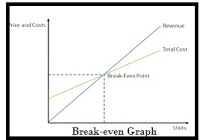How to apply Break-even analysis in Business plan – Variables related to break-even analysis include variable cots, fixed costs, contributions, and break-even point. Others re total quantity produced or sold, turnover, total cost, unit cost and unit selling price.
If you need to know how to apply all of these in your business plan, this article is for you. This article will define the various concepts and show their application in the
business plan. At the end of this discussion you will be able to apply the relevant variables in all of your daily activities. Their understanding will also enable you monitor the achievement of your business plan.
How to apply Break-even analysis in Business plan
In the previous post I have dealt with
CAPEX, OPEX and business
plan assumptions. I advise you read these four topics together for proper grasp of what business plan is all about.
The derivation of Break-even variables:
It is very necessary you derive all of these variables in your business plan forecasts. The
break-even point for a product is the number of units you need to sell to generate a total revenue that equals the total costs. It’s at the point where both fixed and variable costs equal total revenue generated from the project or activity.
The contribution margin ratio is the percentage of contribution margin to net sales.
For production outfits, it’s the point at which the total cost of production equals the total value of goods/services produced. At such a point, there is no profit nor loss.
In your business plan this point is very important. No business succeeds without deriving the break-even values – cost/price, unit/quantity and turnover. This could be a ‘joyful’ or a ‘sad’ moment point. This is because an entire business dream can come to an end here, when it’s found that values generated ar not feasible or can’t be sustained or achieved, meaning that the business is not viable.
Break-even analysis in Business plan
How do you generate these values?
- Variable costs are those cost that vary in relation to the volume of production
- Fixed cost are those cost that do not vary in relation to the volume of production/activity.
- Total cost is the summation of both the variable and fixed costs (OPEX)
- The volume of production means the quantity produced.
- Output/ value is unit cost multiplied by the quantity produced in monetary value.
- Turnover is the unit selling price multiplied by the quantity sold in monetary value
- Break-even quantity is the quantity at which the cost is equal to the revenue it generates. The revenue at this point is the break-even value.
What does Contribution mean?
You know that in production or in marketing, the first thing you want to cover is your direct/ variable costs. That is the essence of contribution. The reasoning is that fixed costs re not paid at every point of production, but it’s the responsibility of the production process to pay off the fixed costs. Therefore it’s assumed that every unit produced makes contribution towards paying the fixed costs.
For example, if a product costs 500 in whichever monetary value (Naira/Dollar/Pound), and is sold for 800, the product has paid off the variable cost nd has made 300 contribution towards the fixed cost.
There in your business plan you must find out the quantity of this product that will contribute 300 each to settle a fixed cost of say, 25,000. Certainly, 84 units contributing 300 will pay off the fixed costs. The business man must know that from the 85th unit he begins to make his profit.
Break-even analysis in Business plan
What is the formula for break even point?
The break-even point formula is calculated by dividing the total fixed costs of production by the price per unit less the variable costs to produce the product.
Other questions are:
What is the break even point? How do you calculate sales volume?
What is the definition of break even analysis? What is the meaning of BEP?
How do you calculate target profit?
Other two concepts that will help you while preparing your business plan and in forecasting turnover, and profit is mark-up and margin.
What I mark-up?
Markup is the ratio between the cost of a good or service and the selling price. It is expressed as a percentage ( %) over the cost.
What is margin?
Profit margin is part of profitability ratios calculated as net income (net profit) divided by revenue/turnover.
How to apply Break-even analysis in Business plan
A proper understanding of these two concepts and their application could bring the turn around you are looking for. They are good tools in the hands of every writer of business plan. The point I’m making is that these will help you generate the various figures you need. Note that determining these figures is one thing while adjusting them to realisable basis is another thing.
I’m sure you re better equipped now to do your business plan by yourself. If you still’ve problem in understanding how any variable works and is applied in your business plan, don’t hesitate to get at me. I’m ready to help you. Gt a plan here
How to apply Break-even analysis in Business plan
A bankable business plan is what you need to access your required funding. Completefmc develops all types, sizes and tenor length of business plan. Our business plan template for palm oil production, rice mill, block industry, distributive business, travel agency business and other service industry are unbeatable. Explore our Bankable Business Plan services offerings for fast growing lucrative profitable businesses today. Contact us on +234 8034347851 or [email protected] to get in touch with us.
Follow us via our Facebook, tweeter and other social networks. You will always get your current business tips, career and recruitment information in this website.
Deacon Anekperechi Nworgu, a seasoned economist who transitioned into a chartered accountant, auditor, tax practitioner, and business consultant, brings with him a wealth of industry expertise spanning over 37 years.





